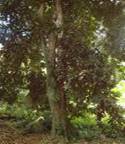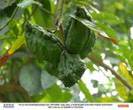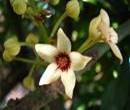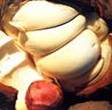| Kingdom | Plantae |
| Unranked | Angiosperms |
| Unranked | Eudicots |
| Order | Malvales |
| Family | Malvaceae |
| Genus | Kola |
| Species | K.vera |
| Binomial name | Kola vera |
Other Common Names:
The other common names for the kola tree are Kola Seeds, Gurru Nuts, Bissy Nuts and Cola Seeds.
History


Description
Kola nut is a caffeine-containing nut of two evergreen trees of the cocoa family. Kola nut is a relative of the Sterculiacea plant family. The Cola acuminata is an evergreen tree of about 20 meters in height, and has long and ovoid leaves pointed at both the ends that have a leathery texture.



Range
Kola nut is native to W. Africa; this herb is cultivated extensively in the tropics particularly Nigeria, Brazil, Sri Lanka, Indonesia and S. America. Though it is a native of tropical West Africa, but has been spread so much by man that today it is cultivated from Senegal to Nigeria.
Habitat
Originally a tree of tropical rainforest, it needs a hot humid climate but can withstand a dry season on sites with a high ground water level. It may be cultivated in drier areas where ground water is available. C. nitida is a shade bearer but develops a better spreading crown which yields more fruits in open places. Though it is a lowland forest tree it has been found at altitudes over 300 m on deep rich soils under heavy and evenly distributed rainfall.
Cultivation
Ripe fruits harvested before the follicles split open, the seeds or nuts are extracted from the follicles and the white aril removed after 5 days of fermentation. Yields of 300 nuts per tree are considered good. Nuts for planting are the mature ones that have undergone after-ripening. C. nitida can also be propagated by cuttings or aerial layering. The seedlings are sometimes raised in pots or in polythene bags before planting out. Field spacing of 10 x 10 m is common. Early weeding is essential and interplanting with a shade tree recommended. Initial growth is slow, reaching only 3 m in 4 years. Slashing the trunk of cola trees before the season of main flowering is believed to induce heavy bearing. Trees start flowering at 4-5 years and very few fruits can be obtained, but full production occurs in 20 years. Cola as an intercrop flowers later than the normal 4-5 years. Seed generally have recalcitrant storage behaviour. Seed can be retained for 1 year or more without loss in viability with seeds wrapped in banana leaves in a basket, or with polythene bags, at room temperature. Nuts may be thus stored for several months without spoiling but will require regular changing of the leaves and checking for weevil damage.
Flowering Season
The yellow flowers of the evergreen tree are in bloom from May to July.
Pests and Diseases
The nuts are subject to attack by the Kola weevil Balanogastris cola. The larvae of the moth Characoma strictigrapta that also attacks cacao bore into the nuts. Traders sometimes apply an extract of the bark Rauvolfia vomitoria or the pulverised fruits of Xylopia and Capsicum to counteract the attack on nursery plants. The cacao pests Sahlbergella spp have been found also on C. nitida as an alternative host plant. While seeds are liable to worm attack, the wood is subject to borer attack.
Parts Used

The seeds are the most commonly used parts of the kola nut tree for its commercial and medicinal purposes.
Medicinal Applications

• It acts as a stimulant to central nervous system, anti-depressive, astringent, diuretic.
• The nuts are chewed as a stimulant and used the roots to clean teeth and sweeten breath.
• Kola has a marked stimulating effect on the human consciousness.
• It is used in the treatment of whooping cough and asthma.
• Kola nuts were also used as a substitute for alcohol in the treatment of alcoholism.
• Africans used the pods to ease labour pains; seeds to relieve diarrhea, childhood asthma, nausea, and hangover.
• Kola nut are also thought to reduce fatigue and hunger, aid digestion, and work as an aphrodisiac.
• It will aid in states of depression and may, in some people, give rise to euphoric states.
• It relieves a few specific cases of depression associated with weakness and debility.
• The herb was believed to boost physical performance by stimulating the heart and also for treating debility, weakness, apathy and seasickness.
• It cures some varieties of migraine also.
Commercial Applications


• Kola nuts are best known outside of Africa as an ingredient in cola beverages.
• Kola nuts and kola extract are used in the manufacture of soft drinks, alcoholic beverages, candy and nutritional supplements.
• Kola nut may also improve athletic performance due to its ability to enhance oxygen delivery and enhance focus.
• Kola nuts, in combination with coca-leaf are incorporated in brands of cocoa, tonic wines and other beverages.

In some parts of Africa, kola nuts are given as gifts to visitors entering a home, usually with some formal ceremony. Offering the kola nut is a gesture of friendship and hospitality. The kola nut ceremony is similar to the traditional American Indian peace pipe or breaking bread in a religious context. Elsewhere, before a marriage, a bag of kola nuts are often given by a groom to the parents of the bride. Kola nuts are a used in rituals performed by religious healers.
Kola nuts are important in many African societies, particularly in Western Africa. Besides the ceremonial uses, many Africans consume kola nuts regularly, even daily, for the medicinal effects described above. Kola nuts are a common sight in African markets in cities and villages. They are often sold by street vendors at bus and train depots. On a train or bus, a traveller with a kola nut will often offer a piece to the others nearby, whether he knows them or not. Kola nuts can be used to enhance concentration and mental clarity during long rituals and meditation.
They can energize prayers or spells. Kola nuts are generally considered as a bringer of peace and may help reaching a decision or agreement among a group of people.' Kola brings life' is a common saying in West Africa where Kola nuts are ceremonially shared as a sign of peace and honour, to welcome friends or strangers, to seal agreements and even to seek favour with the family of one's bride to be. These customs are particularly common among the tribal people, but e.g. in Nigeria the ceremonial sharing of Kola nuts is a respected sign of peace and concordance at all levels of society.